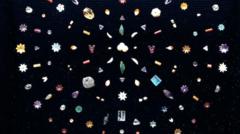Why Did Sotheby's Return Buddha Jewels to India?

Return of Sacred Jewels: The Piprahwa Gems Come Home
The recent return of the Piprahwa Gems, a set of sacred jewels believed to be linked to the remains of the Buddha, marks a significant moment in the preservation of cultural heritage. These jewels, which were scheduled for auction at Sotheby's in Hong Kong, have been reclaimed by India after intense diplomatic negotiations and pressures from the Indian government as well as global Buddhist leaders. This article delves into the history, significance, and implications of the return of these remarkable artefacts.
A Historical Overview of the Piprahwa Gems
The Piprahwa Gems were unearthed in 1898 by English estate manager William Claxton Peppé from a stupa in Piprahwa, northern India, near the birthplace of the Buddha. This remarkable find included nearly 1,800 pearls, rubies, sapphires, and gold sheets, all buried alongside bone fragments that an inscribed urn identified as belonging to the Buddha himself. The discovery was heralded as one of the most astonishing archaeological finds of the modern era.
After their discovery, most of the gems and relics were handed over to the colonial Indian government, while some bone relics were sent to the Buddhist King of Siam (Rama V). A significant portion of the artefacts was later transferred to the Indian Museum in Kolkata, previously known as the Imperial Museum of Calcutta. For over a century, these dazzling jewels remained largely hidden within a British private collection.
The Recent Auction Controversy
The planned auction of the Piprahwa Gems by Sotheby's in Hong Kong ignited widespread ethical concerns among scholars, cultural activists, and Buddhist leaders. Many questioned whether sacred objects, especially those linked to human remains, should be commodified and sold in the market. Critics argued that the seller had no right to auction these relics, which are considered sacred by many Buddhists worldwide, while some defenders maintained that a transparent sale was the fairest method for transferring custody.
In early May, the auction was postponed following media reports and the Indian government's concerns. After a week of ongoing talks with Indian officials, Sotheby's confirmed the cancellation of the sale, which was initially set for May. The return of the gems was finally announced following two months of negotiations among the owner, the new buyer, and the Indian government.
The Role of Godrej Industries Group in the Return
Godrej Industries Group, a Mumbai-based conglomerate with a diverse portfolio including consumer goods, real estate, and agriculture, stepped in to acquire the jewels. The group expressed its deep honor in contributing to this historic moment, emphasizing that the Piprahwa Gems are not just artefacts but symbols of peace, compassion, and shared heritage. Pirojsha Godrej, Executive Vice Chairperson of the group, stated, "We are deeply honoured to contribute to this historic moment. The Piprahwa gems are timeless symbols of peace and the shared heritage of humanity."
Significance of the Relics to Cultural Heritage
The return of the Piprahwa Gems is more than just a legal transaction; it symbolizes a victory for cultural heritage. Indian Prime Minister Narendra Modi hailed the return as a "proud and joyous moment," noting that the relics were coming home after 127 years. The relics will now be on permanent public display in India, allowing people to reconnect with a significant part of their cultural and spiritual history.
Historians regard these relics as the shared heritage of the Buddha's Sakya clan and Buddhists across the globe. The bone fragments from the burial site have since been distributed to various countries, including Thailand, Sri Lanka, and Myanmar, where they continue to be objects of veneration. The significance of these gems extends beyond their material value; they embody the teachings and legacy of the Buddha, making their return to India a monumental occasion for the Buddhist community.
The Ethical Dilemma: Commodification of Sacred Objects
The debate surrounding the auction of sacred relics raises vital ethical questions about the commodification of cultural and religious artefacts. As art historian Naman Ahuja pointed out, treating the relics of the Buddha as commodities poses a moral dilemma. "Are the relics of the Buddha a commodity that can be treated like a work of art to be sold on the market?" he questioned. This underscores a broader conversation about the responsibilities of custodianship and the ethical implications of selling sacred objects.
Critics of the auction also raised concerns about the authority of the seller to auction the relics. Questions surrounding the term "custodian" were prevalent; many wondered on whose behalf the seller was acting. The tension between commercial interests and the sanctity of sacred relics calls for a reevaluation of how such artefacts are treated in the global marketplace.
Public Response and Future Implications
The public response to the return of the Piprahwa Gems has been overwhelmingly positive. Many view it as a triumph of diplomacy and cultural respect. The Indian government's involvement and the eventual return of the relics illustrate the power of international dialogue and cooperation in safeguarding cultural heritage.
Looking ahead, the return of the Piprahwa Gems may inspire similar initiatives for the repatriation of other culturally significant artefacts. As societies increasingly recognize the importance of cultural heritage, the ethical considerations surrounding the ownership and sale of sacred objects will likely continue to evolve. The return of these relics serves as a reminder of the need for sensitivity and respect towards the cultural and spiritual significance of artefacts around the world.
Conclusion
The return of the Piprahwa Gems to India is not only a celebration of cultural heritage but also a significant moment in the ongoing conversation about the ethics of artefact ownership and the commodification of sacred objects. By reclaiming these relics, India has taken a step towards honoring its historical and spiritual legacy. As the jewels are prepared for permanent public display, they will serve as a lasting symbol of peace, compassion, and the shared heritage that transcends borders.
FAQs about the Return of the Piprahwa Gems
What are the Piprahwa Gems?
The Piprahwa Gems are a collection of sacred jewels believed to be linked to the remains of the Buddha. They were discovered in 1898 in a stupa in Piprahwa, northern India, and include a variety of precious stones alongside bone fragments identified as belonging to the Buddha.
Why were the Piprahwa Gems returned to India?
The return of the Piprahwa Gems was a result of diplomatic negotiations and pressures from the Indian government and global Buddhist leaders. Concerns over the ethical implications of auctioning sacred relics contributed to the decision.
Who acquired the Piprahwa Gems?
The Mumbai-based conglomerate Godrej Industries Group acquired the Piprahwa Gems and expressed their honor in contributing to the return of these significant cultural artefacts.
What will happen to the Piprahwa Gems now?
The Piprahwa Gems will be on permanent public display in India, allowing the public to connect with this significant part of their cultural and spiritual history.
What are the implications of this return for other cultural artefacts?
The return of the Piprahwa Gems may inspire similar initiatives for the repatriation of other culturally significant artefacts and calls for a reevaluation of how sacred objects are treated in the global marketplace.
The return of the Piprahwa Gems has not only rekindled interest in these historical artefacts but also sparked discussions about the ethical treatment of cultural heritage worldwide. How do you perceive the balance between commodification and preservation of sacred objects? #CulturalHeritage #Buddhism #PiprahwaGems
```Published: 2025-07-31 06:28:18 | Category: technology



